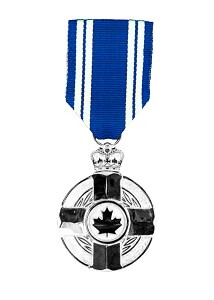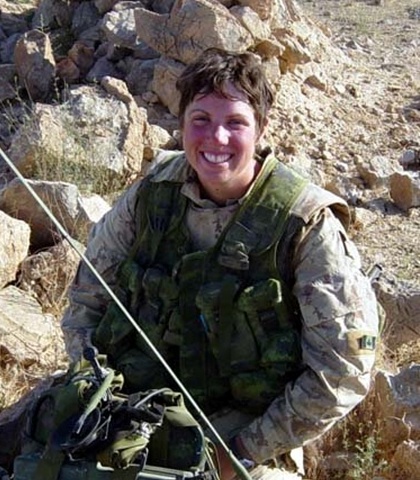
Nichola Goddard
On May 17th, 2006, in the Panjwa’i district of Afghanistan, Canadian Army Captain Nichola Goddard made many “firsts”: the first female Canadian combat soldier to lead Canadian soldiers into combat and the first artillery officer to call in support fire on an enemy since the Korean War, she was tragically the first female combat soldier lost to enemy fire – all in the same battle.
Educators: Click here for a Lesson Plan that explores Nichola’s life.
That battle was the little-known Battle of Bayanzi. Bayanzi was a small village in the Afghan district of Panjwa’i, in Kandahar Province. Acting upon intelligence reports that the Taliban would be making a large-scale attack on Kandahar City itself, Canadian and Afghan National Army (ANA) troops initiated Operation Bravo Guardian near and in the villages on the outskirts of Kandahar. Bayanzi, one such village, was soon identified as an area in which Taliban fighters were massing.
Captain Goddard performed with distinction throughout that day, her calm and collected voice coolly calling out coordinates for her regiment’s 155mm artillery pieces and the American Apache helicopters overhead. Her reassuring presence, though sensed by most only via the radio, and unique role as the only forward observation officer in the area, no doubt played a large role in ensuring her troops’ confident performance. By the evening of the 17th, the Canadian and ANA forces had succeeded in checking the Taliban insurgents, killing forty and capturing twenty with the only casualties being an ANA soldier…and Captain Nichola Goddard.
Captain Goddard’s LAV, an eight-wheeled armoured personnel carrier, had been racing back and forth along the line of Canadian combat vehicles throughout the day’s engagement. As the forward observer responsible for calling in support fire, she and her vehicle had to constantly shift to find the optimal observation spots. It is likely the Taliban caught onto this fairly quickly and made her vehicle the target of their ambush. Shortly after sunset, Captain Goddard and the rest of her company moved into Bayanzi on their way to the west of the village, to where the Taliban had been seen retreating. As the Canadian troops started to turn around in the narrow Bayanzi lanes, two rocket-propelled grenades (RPGs) struck Captain Goddard’s LAV. While the LAV’s hull remained intact, shrapnel ricocheted upwards and struck the back of Captain Goddard’s head, killing her instantly.
“My Sunray’s down! My Sunray’s down!” came the call of one of Captain Goddard’s vehicle crew members over the radio. “Sunray” was the radio callsign of a vehicle crew commander – in this case Captain Goddard. In the last of the sun’s fading light, Nichola Goddard’s tremendously vibrant life came abruptly to an end. “An almost Biblical wrath”, in the words of her father Tim Goddard, was imposed upon those responsible for her death: the M777 155mm artillery pieces of the 1st Regiment Royal Canadian Horse Artillery unleashed a storm of vengeance upon the Taliban positions, supported by an American B-1B Lancer bomber overhead. For her services that day and in the weeks since her arrival in Afghanistan, she received, posthumously, the Meritorious Service Medal and the Sacrifice Medal.

The Canadian Meritorious Service Medal (Credit: DND).
Nichola’s Legacy
Born in Papua New Guinea and having lived in nearly all territories and provinces of Canada, she gave her life doing what she loved and believed in: making a difference in the lives of others. At the dinner table, she would often debate with her parents about the various approaches to alleviating suffering around the world, and would point out the futility of focusing solely on education and schooling unless those seeking to prevent such activities through violent coercion were first stopped. As Captain Goddard’s colleagues regrouped at the village outskirts, the local school, newly repaired by aid organizations but just as quickly burned down by the Taliban and marked with slogans warning students to stay away or face death, was a poignant symbol of the struggle in which Captain Goddard had squarely placed herself.
Nichola’s death in 2006 hit Canada hard. A “daughter of Canada”, there was no shortage of news coverage on the 17th Canadian combat death in Afghanistan. In the years since, dozens of tributes to her life have been established around the country – some as simple as the memorial plaque in her former high school, some as large and complex as an entire Coast Guard ship carrying her name for decades to come. Many of the initiatives that have taken place in honour of her memory were and are led by the Nichola Goddard Foundation.
At the University of Calgary, the Captain Nichola K. S. Goddard Memorial Scholarship was set up for applicants coming from any of the following groups: citizens of Papua New Guinea (where she was born); First Nations, Inuit, or Métis (people with whom she spend so much of her early years); and citizens of Afghanistan (where she died). At the University of Prince Edward Island, a similar scholarship was established for those seeking to conduct a project related to indigenous peoples both in Canada and abroad. As well, the Canadian Islamic Congress has the Nichola Goddard Scholarship in Peace and Conflict Studies, a scholarship set up to promote the peaceful resolution of political conflicts.
In Papua New Guinea, the Nichola Goddard Light Up Papua New Guinea project seeks to bring solar-powered LED lighting to the rural health facilities in that country. By establishing sustainable electric lighting, health facilities will be able to function at night, significantly improving the quality of health care in the country.
Back in Calgary, the new Captain Nichola Goddard School in Panorama Hills houses a Grades 4 through 9 middle school. In Sault Ste Marie, Ontario, where Captain Goddard’s grandparents reside, a park near an elementary school has been opened in her name. At the Royal Military College in Kingston, the Captain Nichola K. S. Goddard Memorial Sword is presented to the top artillery senior cadet in the fourth year of their Regular Officer Training Plan.
In the Canadian Coast Guard, Captain Goddard’s spirit will live on as the CCGS Captain Goddard M.S.M., last of the nine new Hero class Mid-Shore Patrol Vessels (MSPVs) currently being built by Irving Shipbuilding in Halifax, Nova Scotia. At 43m long, these ships are capable of operating up to 120 nautical miles from shore, and will enforce our country’s maritime regulations, enhance maritime security, as well as quickly respond to any maritime emergencies. The CCGS Captain Goddard is expected to be commissioned in 2014, and will serve for decades to come.
Captain Goddard’s sacrifice also served as the inspiration for the Canadian rock band The Trews’ 2010 single, Highway of Heroes. Nichola was a schoolmate of several of the band’s members and the song is a tribute to all the fallen soldiers who returned home via Highway 401 between Canadian Forces Base Trenton and Toronto.
To further explore Nichola’s life, visit the Nichola Goddard Foundation.
Resources for Educators:
Click here for a Lesson Plan that explores Goddard’s story or here for a learning resource: Nichola Goddard Q & A worksheet (Bloom’s Taxonomy).
Main photo: Nichola in Afghanistan (Credit: Nichola Goddard Foundation).
VALOUR CANADA wishes to acknowledge The Poppy Fund, Calgary Foundation and Veterans Affairs Canada for their generous funding of MONUMENTAL CANADIANS.



